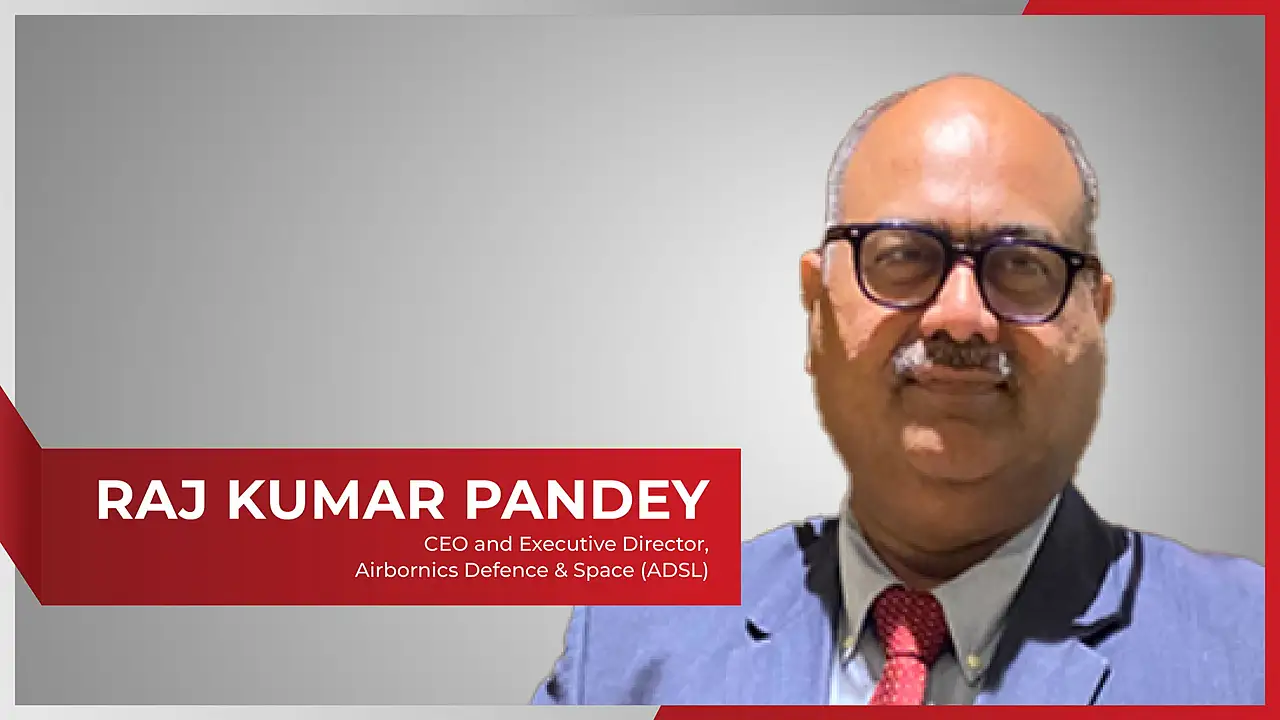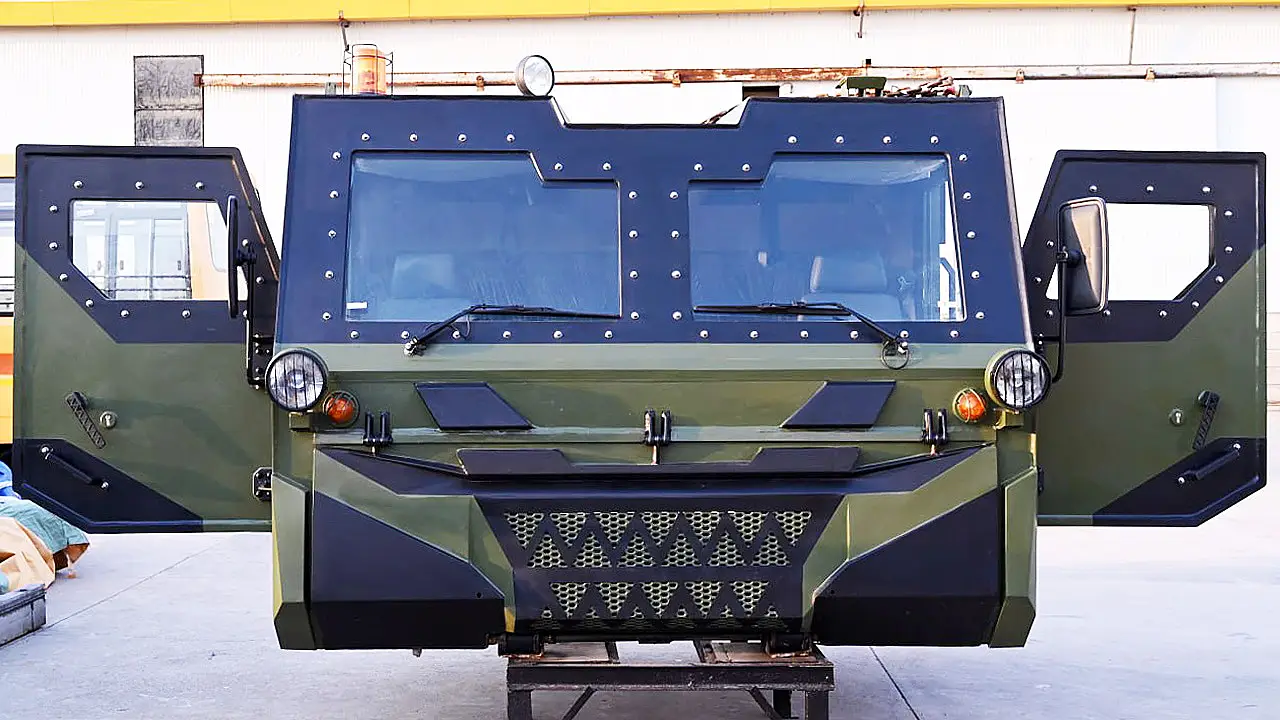
Raj Kumar Pandey is CEO and Executive Director Airbornics Defence & Space (ADSL), a JCBL group company. He started his career with Mahindra and Mahindra, where he remained till 2004 and was later closely involved in the creation of Mahindra Defence Systems. During this time he also worked closely with multinational firms such as BAE Systems, Ricardo and FIAT. While part of Mahindra Defence Systems and working with BAE Systems, he was posted to Sweden, where he worked on the CV90 armoured vehicle programme. He left Mahindra Defence Systems in 2018 to setup ADSL as a joint venture with JCBL. He is a graduate of IIT Kharagpur.
What are the market sectors that ADSL is targeting?
ADSL is organised in four verticals. Our first vertical is aerospace, where we are into aerospace cargo solutions, and working on products such as cargo drop systems. This has been part of our evolution over the last three years and we have successfully tested our cargo drop systems. We also do work on ground support vehicles for the aerospace domain, such as manipulators and loaders, which are very sophisticated hydraulic equipment. We also do some work in aerostructures and associated subsystems.
Our second vertical is related to armoured vehicles, which is an old legacy capability of JCBL, where we are very strong in terms of vehicle armouring for wheeled platforms. We have taken this capability further and started working on mobility platforms.
A recent example of this is the work we have done for Mounted Gun System (MGS) programmes of Bharat Forge and Tata Advanced Systems (TASL) in partnership with Vehicle Research and Development Establishment (VRDE), Ahmednagar, which is a Defence Research & Development Organisation (DRDO) lab. The MGS is a 155 mm truck mounted artillery system.
Our third vertical is related to combat vehicles, but here we are not doing full systems, like we do in armoured vehicles. Instead, we have organised ourselves to focus on the technologies. Working on a combat vehicle is a very, very complex Multiphysics area. We are working on the turret and Remote Controlled Weapon Systems (RWCS). We are not into weapons themselves but are into the control systems, mechatronics for RCWS.
ADSL is also involved in work related to the indigenisation of the Indian Army’s Russian origin T-72 and T-90 Main Battle Tanks (MBT). We are working to increase the capability of these MBTs by indigenising spares to reduce import dependency and improve the overall serviceability of the fleet.
Our last domain, which is an upcoming domain, is defence electronics, where we are focussing on unmanned systems. We have done work from the ground up on large birds – about 35-100 kg class Unmanned Aerial Vehicles (UAV). The work we are doing on Unmanned Aerial Systems (UAS) can also translate into Unmanned Ground Systems (UGS). We are also looking at building Optronics capability, which allow us to meet the surveillance needs of the armed forces. These are the four verticals that we have within ADSL.
We have a wide range of technologies also available to us within the broader JCBL Group. Our group company MSL is into fabrication and we make use of their facilities, for composite. They are a leading company for glass reinforced plastics and we are using this capability to develop airframes. We are also growing our capabilities with regards to carbon structures, which will help our future products.
Developing an aircraft cargo drop system is a complex endeavour. What are some of the challenges?
We had two major challenges; one was related to metallurgy and other was skills for niche aerospace programmes. As a country, we are very weak in metallurgy. If one needs to source specialised material, we normally don’t have the sources here, we have to depend on other countries that are very good at metallurgy. As a result, we had to develop some of these things ourselves.
When you look at an airborne cargo drop system, it has to be very low weight, yet very strong. Any increase in weight penalises the drop payload. So if we need to drop a 20 tonne payload, we need the cargo drop system to have a good payload to weight ratio. We had difficulties sourcing the specialised high strength steel, and there was no capability to machine, forge and heat treat such high strength steel in India. We have now developed sources in India.
The other issue we faced was related to the skills available for undertaking niche aerospace programmes. For developing a product like a cargo drop system, it was hard to find skilled personnel and as a result we had to take personnel with good potential and then develop their capabilities to address our requirements. When one has access to such skilled personnel, development becomes easier, as here in India, we are very good in the design aspect.

We are working with DRDO on the cargo drop system and have already delivered five systems, which are undergoing trials. We have already completed a lower weight trial at 12 tonnes payload. We are hopeful that trials will be completed by 2024 and we can start production.
What are the market prospects for your aircraft cargo drop system?
It is a little difficult to talk about the actual mission profile for such a system as it is a product for the military. However, if you look at it in a broad sense, there are 4-5 areas where such a system can be deployed and typically, this is in peacetime. So, when we require to deploy troops and material to various locations, the potential for such cargo drop systems is huge.
They are used for positioning of material prior to a conflict, when the armed forces are mobilised. I am talking about strategic mobility, which involves transport of material over long distances and not tactical mobility, which involves transport of smaller payloads over shorter distances. We cannot name the aircraft that we are developing the cargo drop system for, but, whichever foreign country uses this aircraft will also be a potential export opportunity for us.
The Indian Government is now very supportive for export endeavours with good support from our embassies abroad as well. Cargo drop systems also have applications in humanitarian and disaster relief operations. This is a very promising area for us and I think in the coming times, we will be flush with orders.
Please provide an insight into some of your other products at ADSL?
We are also working on a 20 tonne cargo loader. While loading heavy cargo onto an aircraft looks simple, it is not. An aircraft which is parked on tarmac has its own degrees of freedom and when you want to load a 20 tonne payload, you have to align it to the rollers on the tail doors for alignment. So, the loader not only needs to be able to lift the payload and place it inside the aircraft, it also needs to be able to manipulate the payload in terms of yaw, roll and pitch. This allows the payload to be placed precisely inside the aircraft.
This system is now under trials and when completed, will give us access to new markets. The product can be modified for various other applications. We are also working on a Ground Power Unit (GPU), which supplies power to the aircraft, when it is on ground. Aircraft when they are on the ground, do not use their engines for power but use external power. We are also working with glass reinforced plastics with JCBL and have developed a carbon layup systems where we will be able to develop aerospace structures.
We are very strong in vehicle armouring. In the past, I was involved in the development of various medium bulletproof vehicles, which were inducted successfully in some markets. At JCBL, we do vehicle armouring for Toyota and Mercedes Benz vehicles and have a good presence here. We not only look at the vehicle survivability but also on aspects such as ballistics and blast protection.
An important milestone for us is the work we have done to completely refurbish a T-72 MBT, which we have delivered to the Army for evaluation. Once selected, we expect to undertake this work on at least a few hundred T-72 MBTs. We are also working on manufacturing the complete hull of the T-72 and have already bagged an order for two hulls.
Lastly, we have started maiden trials of our UAS products as well.

Do you believe there are export prospects for the work ADSL is doing on T-72 and T-90 MBTs?
This is a definitely a good opportunity for any Indian company like us, not only for the Indian market. But if you look at other countries, and with the current scenario of Ukraine versus Russia, these countries are not getting support for their platforms, especially with regards to spares. We are in a very strong position to provide this support capability to Southeast Asia, in countries like Vietnam and Malaysia. Egypt also has a large Russian fleet.
At ADSL, we are looking very seriously at this and that is why we started working on T-72. We have developed the capability to refurbish a T-72 hull and make it operational in the past year. These are still very complex and heavy machines. For example, the T-72 hull is made using a technique that is not used in India and this is something that we had to learn and adapt to.
If we have to get into this, metallurgy is again going to be very challenging. The hull is 60-70% metal and if we depend on outside sources for the metal, then typically 30-40% of the value is controlled from abroad. The biggest challenge we are facing right now is metallurgy and the process. It is also difficult to handle the complexities of the powertrain and needs to be handled in a different way. The other areas are manageable and Indian companies should grab this opportunity.
Also Read
HTS India Aerospace Eyes Growth In Indian Drone, Defence Markets
Also Watch
“We See Huge Opportunities In Aerospace Led By defence, Design-led Manufacturing, Digital”